Suddenly Trakehners are well and truly back in the spotlight, but that should be no news to THM readers, since Jan Tönjes highlighted their re-emergence ten years ago. Sit back and enjoy Jan’s special insights into this noble breed…
Take the looks of Cate Blanchett, add the brain of George W. Bush jun. and finally give a little bit of Dame Edna’s hysteric extravaganza – what do you have? A product good to look at from a distance, maybe entertaining for a while but not the kind of thing you really want to mess around with. Fifteen years ago you would have found plenty of horse fans in Germany to suggest that the four legged version of the creature described above would have been a typical Trakehner horse – beautiful, but more or less useless, sometimes even dangerous. Many prejudices about Trakehner horses have to be re-examined as Jan Toenjes reports.
Talking about Trakehner horses is always talking about history. Why? Because no matter if one loves Trakehner horses or not, it’s a simple fact that no other riding horse breed looks back on a tradition as long as the Trakehner. In 1732 Prussian King Frederick William I founded the stud in Trakehnen in East Prussia, a region now partly belonging to Russia and to Poland. Thoroughbreds were frequently used in the Trakehner breed.
Of course riding horses those days meant mainly the production of horses suitable for the cavalry. Sound, willing, and with lots of stamina. Until the 1920’s no-one really thought about tempi changes, oxers or three-day-events – although eventing has its roots in hunting and the state stud at Trakehnen was the scene of many cross country steeplechase/hunter competitions.
A typical young horse competition at Trakehnen – these were three year olds that were broken, then hunted and sold through the stud. These sales were partly the model for Hans Joachim Köhler when he established the Verden Sales in the 1950s…
Early in the 20th century there was the overwhelming number of 25,000 mares and 1500 breeding stallions registered with the Trakehner association. The main stud Trakehnen itself being home of more than 1200 horses.
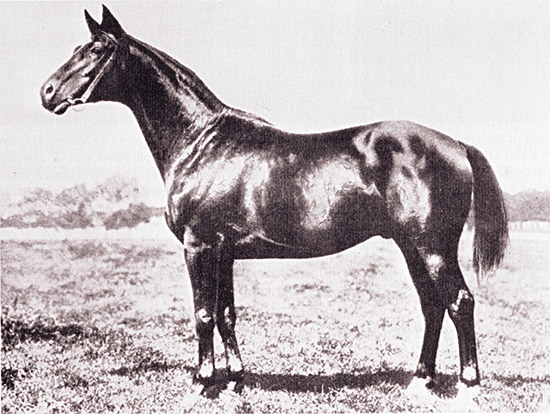 Templehüter – foaled in 1905, an extremely successful sire, standing from 1909 to 1932. His female progeny were the most valuable mares in the Trakehnen herd. What a modern type he was!
Templehüter – foaled in 1905, an extremely successful sire, standing from 1909 to 1932. His female progeny were the most valuable mares in the Trakehnen herd. What a modern type he was!
One of the Trakehner stars at the 1936 Olympic Games – Absinth with Major Friedrich Gerhard
After World War II
The War to end all Wars as British propaganda would have it, achieved its most important goal, that was to destroy the Hitler regime in Germany and bring peace to all the nations that were occupied by Nazi troops. But it seemed for quite a while that it was also the war to end the Trakehner – the breed that before 1941 was not only one of the largest horse populations in Germany, but the one with by far the most modern breeding programme.
In those pre-WW2 years hardly any of the other famous studbooks of today focused on the production of sport horses. Holstein and Oldenburg kept their eyes on coach horses and on working horses, Hannover was producing horses for the cavalry and Westphalian farmers would collapse with laughter at the suggestion of breeding horses with only one purpose, namely to put a saddle on and ride either dressage or even jump over fences. If there were horse shows in the 1940s then the broodmares that day by day pulled carts or ploughs, would have to serve as show horses on weekends.
In 1936 the Olympic Games took place in Berlin and Trakehners won six Gold Medals. Kronos and Absinth won individual Gold and Silver medals in dressage and Nurmi was the Olympic champion in three day eventing. Pure bred Trakehner horses can only have Trakehner, Thoroughbred, Anglo-Arab or Arab parents. This concept made the horses unique among all other warmbloods in Germany, most of whom were at some stage in their history bred for agricultural rather than equestrian pursuits.
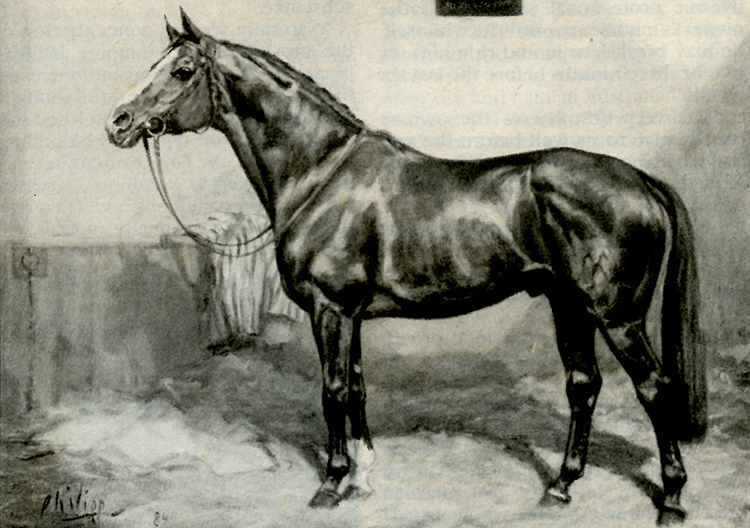
Absatz – popular in Hannover
Trakehners influenced several breeds, namely the Hannoverians. The Hannoverian breeders made a huge step in the direction of the modern riding horse when the half Trakehner, Absatz, by Abglanz, turned out to be a top producer, especially of horses for the dressage ring. Absatz’s offspring weren’t always the picture perfect example of a model horse – sometimes weak in the back, sometimes not too active from behind and, yes, spooky – but Absatz changed the world. All of a sudden elegant foals with that certain look would appear next to mothers that still looked like a mixture of drafthorse, dairycow and lorry. The influence of Absatz is still to be found in stallions such as Akzent II or Argentinus.
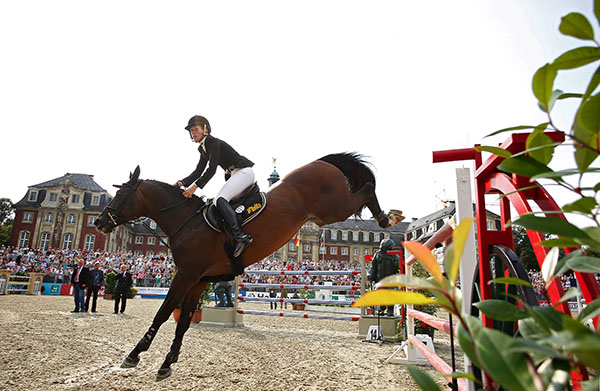
Stakkato and Eva Bitter
Stakkato, top sire in the Celle State Stud and internationally successful showjumper ridden by Eva Bitter is also of Trakehner origin, his pedigree via Spartan/Servus/Sesam/Senator can be traced back to Semper idem by Dampfross.
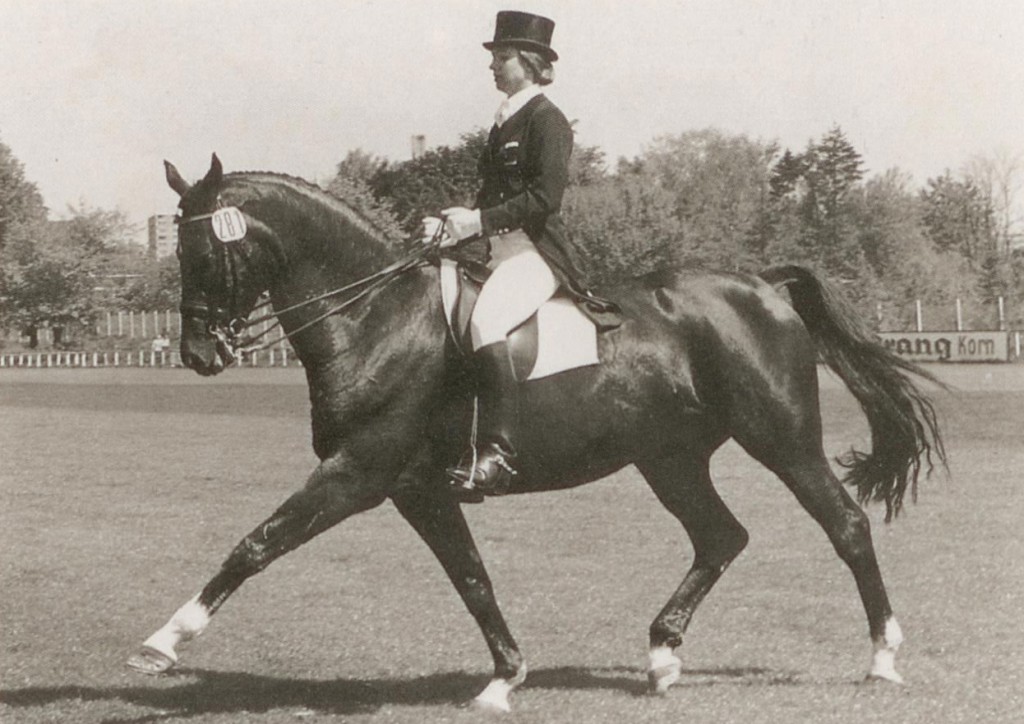 Ultimo and Gabriela Grillo, stars of the 80’s
Ultimo and Gabriela Grillo, stars of the 80’s
But first another short step back into history. In the 1950s famous dressage riders in Germany such as Willi Schultheiss, Harry Boldt or Otto Lörke would ride Trakehner dressage horses, in the 70s and early 80s Gabriela Grillo’s Ultimo was Germany’s top dressage horse, Team Gold winner at the Montreal Olympics. Hirtentraum with Uwe Sauer as well as the gorgeous black mare Kleopatra, one of the last horses competed by George Theodorescu, were perfect examples of good sporthorses.
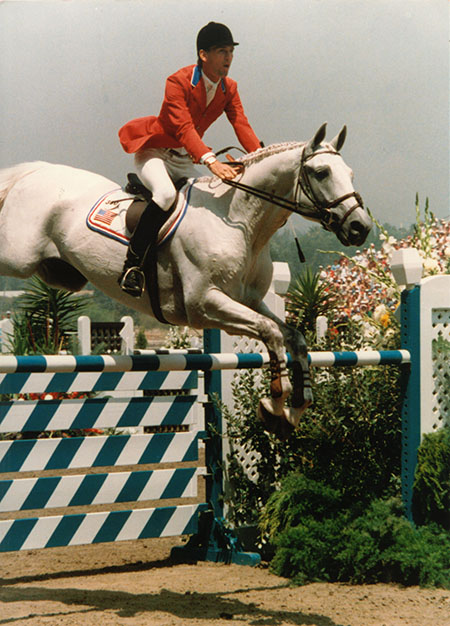
Abdullah and Conrad Homfeld
In eventing it was Habicht ridden by Martin Plewa, who later became Germany’s eventing team coach, who helped the Trakehner horse to gain a good reputation among sport riders. Finally Abdullah, Conrad Homfeld’s legendary grey stallion and Anne Kursinski’s Livius were international perfomers branded with the double elk horn, the registered trademark of German bred Trakehners.
So far a story of success – literally a rise like a Phoenix since the Russians left hardly more than ashes in the once flourishing main stud of Trakehnen. But of course there is a but, a BUT in capital letters. Trakehner breeding politics definetely took the wrong path in the 1970s. The idea of having something special led to a false goal – beauty. It was no longer performance that was important but beauty. More and more Trakehner breeders concentrated on beautiful faces, straight limbs and forgot about things like rideability or jumping ability.
By the end of the 70s some of the wiser Trakehner breeders realized this was a problem – maybe as serious as the situation after World War II. Stallions with weak toplines, flat movements and no eagerness to work became extremely popular. If the progeny of these kind of fashionable stallions would refuse to work, then Trakehner breeders would often blame the problem on the rider: “He’s just not able to ride something so special and sensitive as a Trakehner”. One of the biggest problems was stiff legged movements without any knee action. Horses that move very flat, more like skaters than the dancers required in the dressage ring.
‘Stiff and beautiful’ were the distinguishing features, and no other warmblood breed was interested anymore in the Trakehner horse. At the same time, the number of sport riders looking especially for a Trakehner declined, since with the decline of the Trakehner breed, came the rise of other warmblood breeds such as the Westphalians, Oldenburgs, Hanoverians or Rhinelands. The absence of jumping ability in the Trakehner breed became proverbial in the 1980s, no matter how high and well Abdullah jumped.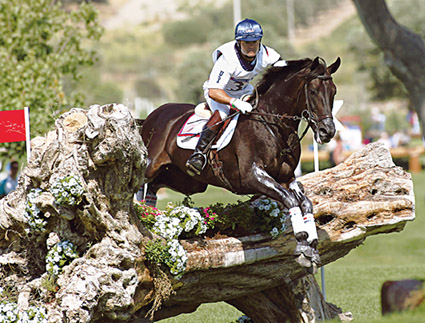
The modern Trakehner eventer in action – Windfall and Darren Chiacchia
However there were still a lot of eventers that did a good job. For example, Habicht whose Anglo-Arab sire Burnus was ridden by Dr Reiner Klimke early in his career while he was still an event rider. Thirty years later it was Klimke’s daughter Ingrid who competed Windfall by Habicht in international 3 star events. The graded stallion, whose dam Wundermaedel is a pure bred Thoroughbred, was reserve horse for the 2000 Olympics in Sydney for the German team, before being sold to the US to continue his career with Darren Chiacchia. He won the Pan American Championships, and was a member of the bronze winning US-Team at the 2004 Olympic Games at Athens. Individually he finished 12th.
By far the most important among Habicht’s sixteen graded sons is Sixtus. An eye-catching black standing at 16.1 hands, his career started at the grading where he was awarded a premium and was named best jumper of the year. As a six-year-old Sixtus went into training with Gilbert Böckmann who qualified him for the World Young Jumping Horse championships in Zangersheide.
Sixtus – the Trakehner ‘diva’ who despite his good looks could really jump!
With a total of more than 50 placings in 1.40 metre classes and four wins, Sixtus is something special in the Trakehner breed. His jumping index based on the scores the offspring received at mare inspections, horseshows and gradings is 138 points – no other Trakehner stallion was able to come close to that in the past decade. Sixtus seems to know of his outstanding position – he’s a male diva so to speak.
Sixtus sired Altefled’s Rob Roy who after winning the Bundeschampionat is now on his way to the top in German eventing, already winning regional championships.
Among the first stallions to be graded there was Buddenbrock – another black modern Trakehner who found his new home at Hoerem stud with the Poll family of very influential breeders. Buddenbrock stood next to legendary halfbred Consul. Buddenbrock was competed from novice to intermediate level in 3-day-eventing and stood for a couple of months at German eventing team member, Andreas Dibowski’s barn. “Dibo” placed Buddenbrock at the Bundeschampionat. There is continuity in that like his grandfather Sixtus and great grandfather Habicht, Buddenbrock throws offspring that excel in both showjumping and dressage.
At the millenium approval Buddenbrock caused quite a stir when out of his first crop, the champion stallion King Arthur and the premium stallion Connery were graded. King Arthur was purchased by Petra Wilm, a member of Germany‘s B-squad dressage and president of the Trakehner association, for 350,000 Dmarks. Connery remained with the Polls who raised both stallions and is now, although still standing at Hoerem Stud, listed as Hannoverian state sire and can be booked via the Celle state stud. A picture perfect example of a refined Trakehner stallion Connery was in the eyes of Dr Burchard Bade, Celle state stud director, a perfect match for those Hannoverian mares that lacked that certain something often referred to as “modern”. So far Connery has not yet proven to really fulfil these expectations in the Hannoverian breed but in his home studbook he was able to present a very nice and subtle bay stallion, the reserve champion of the 2005 grading.
King Arthur, also already sire of several graded sons – one of them a sublime bay presented at the 2005 Oldenburg grading by Paul Schockemöhle – who in former times would never even consider buying a Trakehner, another example of how the evaluation of these horses has changed in the past years! King Arthur made it to the finals of the World Championships of Young Dressage horses and is already internationally successful in the small tour.
Buddenbrock also sired another champion stallion, In Flagranti now owned by the Bavarian State Stud Schwaiganger south of Munich. For quite a while it seemed Buddenbrock would sire more approved stallions than sport horses but in the past two years the number of Buddenbrock offspring successfully shown on renowned horseshows has increased. One of them is Hinnerk owned by Holger Schmezer, Germany’s national dressage coach and ridden by Carola Koppelmann.
Axis is another son of Sixtus who was accepted by the Hannoverian association after finishing a very good performance test in Neustadt/Dosse. This black stallion, who is owned by British pair Sean and Marc Reade of Bluewood Trakehners, was the best jumper of his grading and it was his son Hirtentanz that won this title in 2005 – no doubt this Trakehner is the complete opposite to every prejudice one may have against Trakehners. Not a real beauty this colt jumps like a Holsteiner, the kind of a horse you can easily imagine to meet as “Eurocommerce Hirtentanz” in any class of an international show.
Even more famous among sport riders but never really so popular as Sixtus was Consul by the Thoroughbred Swazi. Australians may know Consul as sire of Ricky McMillan’s Crisp who is far from the only top dressage horse that this bay stallion produced.
Hinnerk and Carola Koppelmann at the Bundeschampionate
Consul was a very handsome horse with a beautiful big eye and a stunning presence. Hubertus Poll would only put a rope around the stallion’s neck and take him out to show him in the yard of Hoerem stud where Consul did what was his duty. He stood like a monument, even if mares or foals would appear. A true gentleman, really awesome – yet Consul’s offspring seldom showed the beautiful head of their father (Crisp of course is a notable exception.) In fact you don’t want to talk about mules but big heads and long ears were often a typical mark for Consul’s crop. At the beginning of his career the Consul-mania worked well and many graded stallions, even champion stallions seem to secure the line for the generations to come, but at the moment, the number of stallions carrying this special blood is decreasing.
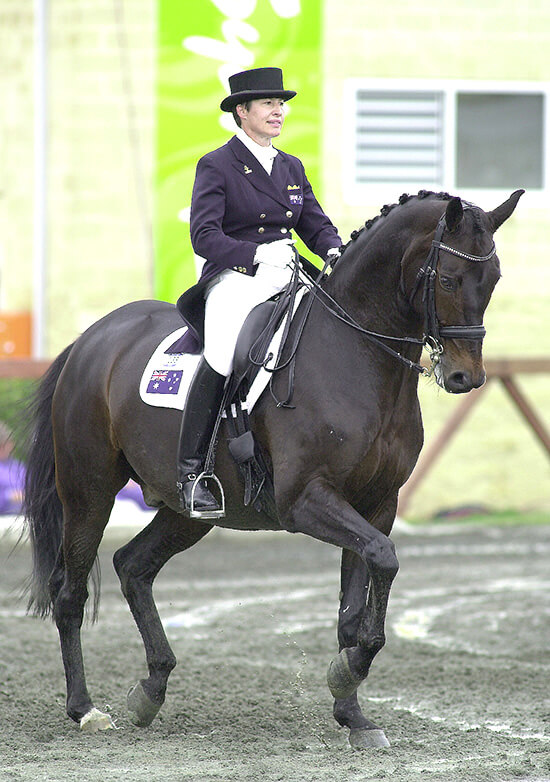
Ricky McMillan and Crisp at the Sydney Olympics for Australia. Crisp had his father Consul’s beautiful head…
The breeders had a problem. Ever tried to sell a Trakehner foal with a plain head? Ever tried to get good scores at the inspections? Forget about it! So many breeders used other stallions, neglecting the fact that Consul sired international performers for dressage and eventing (Vilano was in the German eventing team at the WEG in Jerez 2002) and a large number of at least fairly good showjumpers.
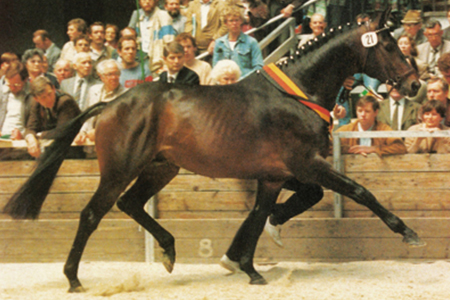
Consul
It was in his last years – Consul died in 2000 – that the quality of Consul’s daughters became popular especially in Hannover. Hoerem Stud is only half an hour away from the Hannoverian headquarters in Verden. Hannoverian Champion stallion Don Frederico, right now the talk of the town because of his outstanding offspring, is out of a Consul dam and so is Celle state stud’s Don Vino. Finally it was Donnerberg TSF who supported his sire’s reputation: with more than 150 wins in Prix St Georges and intermediate. This gelding with the spectacular trot was another example of the kind of Trakehner one just would love to ride. At least once. Across the diagonal in extended trot…
This is just the first of a series of articles – watch this space for more to come…
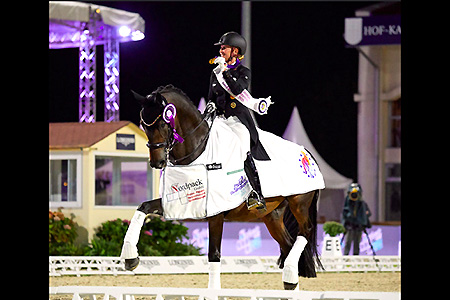


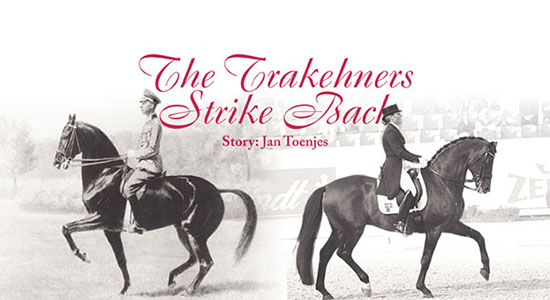
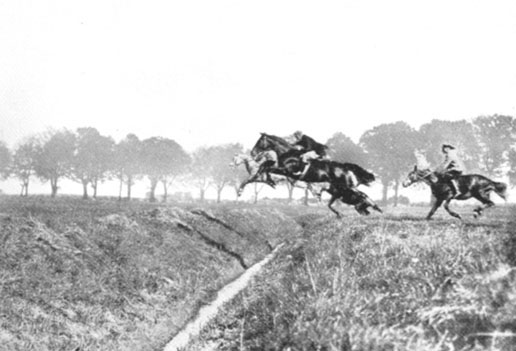
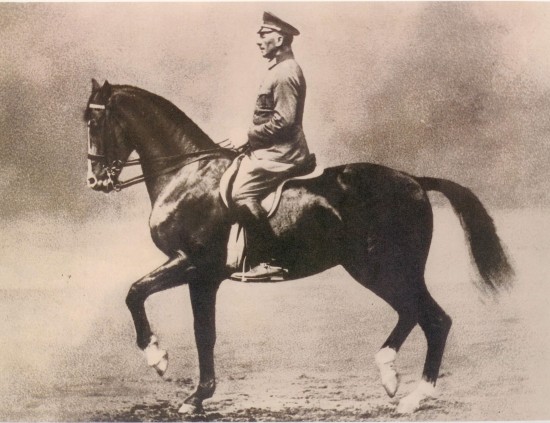
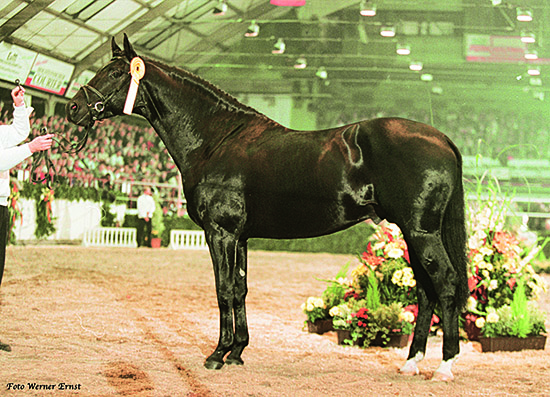
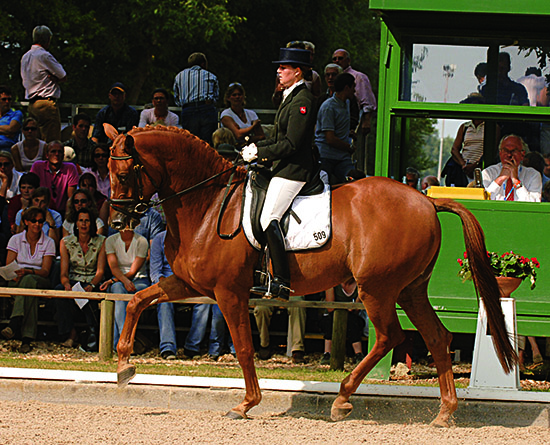
Fantastic article thank you for publishing this insight into the wonderful Trakehner Breed!
Many thanks
Great article, Jan!